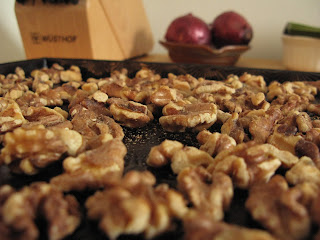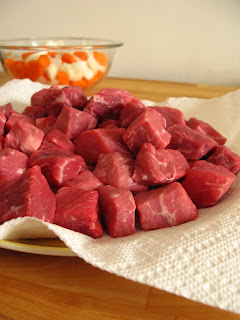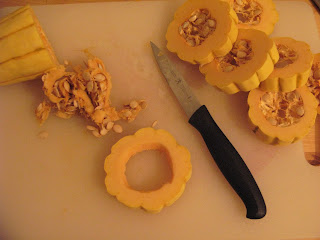The lovely delicata squash...where have you been all my life? You've been aptly named; next to your larger, more ungainly cousins (the spaghetti squashes, butternut squashes) your petite size and yellow rind with striations of deep green and fiery orange make you a hard little squash to resist. The delicata squash is a friendly squash to work with too. It has a very thin rind that, when roasted/cooked, can be eaten along with the flesh of the squash. Less prep work is always a bonus. I would even venture to say that of all the squash varieties I've tried, this has been one of the sweetest, creamiest, and most flavorful ones I've encountered.
This is a recipe that I've been sitting on for a little while now. Back in the thick of December school and concerts, A and I visited one of our favorite neighborhood haunts, Vesta: Simple and satisfying Italian with a focus on local and sustainable ingredients. This recipe is my adaptation of the original dish we ate since with each bite I focused all of my senses to try and parse out what the dish's components were. Tender, creamy, sweet rounds of delicata squash. A salty, tangy, bacon-y vinaigrette made with pancetta. Leaves of frisée and radicchio whose bitterness is the perfect contrast to the richness of the squash and vinaigrette. Pomegranate seeds that (both visually and in eating) provide a pop of color and sweetness. I was especially happy to find this dish since I knew it would be a perfect (and dairy and gluten free!) addition to the upcoming holiday meals which my sister would appreciate.
This dish has now had two highly successful runs. The first was a meal with friends where we gathered to "celebrate" the end of the Mayan calendar and perhaps the world??? We figured that if the world were to end, we might as well go out with bellies full of tasty food. This salad was in good company with a couple roast ducks, roasted veggies, and an herbed sweet potato gratin.
The second was during Christmas, and this year I was overwhelmed with love/happiness/good feelings to spend the holiday with my family and A's family all gathered under one roof. And yes, my sister loved the salad. Left-over salad was consumed over the next few days, even with turkey and between two slices of bread; a twist on the post-holiday turkey sandwich.
The trickiest part of making this dish may be simply finding the squash itself. Even in NYC I had a hard time. I ended up finding them at the Italian wonderland Eataly (which was handy cause I was able to buy a beautiful slab of pancetta while I was there!). Finding delicata squash may mean a pilgrimage to a high-end grocery store with a vast selection of produce. If you're unable to find delicata, you could probably substitute a butternut, kabocha, or sweet dumpling but all of these varieties will need peeling and a bit more work.
Roasted Delicata Squash Salad with Warm Pancetta Vinaigrette.
2 delicata squash (about 1-2 pounds each)
1 small head of radicchio
2-3 bunches of frisée
1 pomegranate
 For the Vinaigrette:
1/4 pound pancetta, small dice
2 tablespoons minced shallots
For the Vinaigrette:
1/4 pound pancetta, small dice
2 tablespoons minced shallots
1/4 cup red wine vinegar
1 tablespoon dry white wine
2 tablespoons maple syrup, Grade A preferable
1 to 2 tablespoons fresh lemon juice
***Note on the Pancetta: If you buy pancetta in a slab like I did, it might still have a layer of skin on it. You'll want to remove with a paring knife, being careful to not lose too much meat/fat in the process. Also, I found that pancetta with a ratio of 1/3 lean meat to 2/3 fat gives the best results. You can just eyeball the pancetta. The fat is the white and the red is the lean meat. Too fatty, and you will not end up with enough of the lovely, crispy bits of meat. Too lean and you may not render enough fat to get the right proportion of fat to vinegar for the vinaigrette.
Preheat your oven to 400F
Start by preparing your delicata squash. I found that as far as final presentation is concerned, you want to end up with whole rings of squash. This means you
do not want to make a long, horizontal cut along the squash. Instead, working with a sharp knife, cut a small slice (no more than 1/2") off of either end to end up with a clean cut and to get rid of the stem. Next, move along the squash cutting rings of squash that are each about 3/4" wide. Remember that you do not need to peel the squash!

When you have your rings of squash, take a small paring knife and move along the inside of the ring cutting just enough to remove the strings and seeds. Lightly greese a cookie sheet with olive oil and lay the rings in a single layer to ensure that you get even caramelization on each ring. Bake the squash for 30 to 45 minutes until tender when pierced with a fork. After about 10-15 minutes, check on your squash to see if the first side has begun to get a nice golden brown color to it. If so, give all of the rings a flip with a spatula to get some color on the other side. Keep an eye on your squash. Depending on the size of your oven, your rings may brown more slowly or more quickly and you definitely don't want to end up with squash that is burnt on the outside and undercooked in the center.
While the squash is roasting, begin prepping the rest of the salad components.
Here's a great method for getting the seeds out of the pomegranate without making a huge, gory mess: fill a large bowl with water. Cut your pomegranate into quarters and submerge in the water. Get in there with both hands (always fun!) and separate the seeds from the outer rind and the inner, white membrane. This method works so well because the heavy seeds will sink to the bottom of the bowl and the membrane will float to the surface where you can skim it away. Now, you can scoop up all of the seeds from the bottom of the mixing bowl and put them in a smaller bowl or on a plate that has been lined with a paper towel to let them dry.

Take the head of radicchio and remove a couple of the outermost leaves. Cut the head of radicchio in half and then proceed to cut into medium sized ribbons. Frisée is usually sold as a small bunch of slender, curly leaves that are joined at the base. Give the bunch a rinse under the faucet, a quick dry, and then simply cut at the base to separate the leaves. You want to end up with a ratio of about 2/3 frisée to 1/3 radicchio. Interesting note: both of these leafy vegetables are related. They come from the Chicory family.
When you have about 10 minutes left on your roasting squash, begin to make the pancetta vinaigrette. Put a dry skillet over medium-high heat and let it get nice and hot. You don't need to put any oil or butter in the pan; all of the fat you will need will render out of the pancetta when you cook it. Put the pancetta in the hot pan and cook, stirring frequently, until the fat has rendered out and the lean meat has become brown and crispy. Using a slotted spoon, remove the pancetta and place on a plate lined with a paper towel.
Ideally you will end up with at least 1.5 Tbs of drippings/fat left in the skillet. The slab of pancetta I bought yielded pretty much exactly that. If you do end up with an excess, take out enough of the drippings so that you end up with 1.5 Tbs. Over medium-high heat, sauté the shallots until they are soft and translucent. Add the vinegar and wine and cook for 2 minutes, then add the syrup and cook for 1 minute more. Take the skillet off the heat and add in your lemon juice.
Put your frisée and radicchio in a large mixing bowl and when the vinaigrette is cool enough (but still warm) add to the bowl and using salad tongs (or your hands!) toss the leaves to make sure they are evenly covered.
If you're plating family-style, put a genrous bed of the leaves on a large plate or platter. Next, place a layer of the roasted rings of delicata squash (as artfully as you feel inclined to do so) on top of the frisée and radicchio. Finally, sprinkle the crispy pancetta bits and about 1/2 cup of pomegranate seeds over the whole thing.
If you're plating individually, follow the same steps as above and (for a generous salad course) top with 3 rings of squash.
This salad has to be one of the most festive, most beautiful, and most delicious salads I've ever made or eaten. Please enjoy!
Click to see savings
1 tablespoon dry white wine
2 tablespoons maple syrup, grade A preferable.
1 to 2 tablespoons lemon juice
***Note on the pancetta: If your pancetta still has its layer of skin on it, make sure you discard before dicing. I think for the best results, you want pancetta that has a ratio of about 1/3 lean meat to 2/3 fat. Just take a look and eyeball the ratio of white (the fat) to red (the lean meat). Too fatty and you won't get any any nice pieces of cooked meat in your final product. Too lean, and you won't have enough drippings to have the proper fat/vinegar ratio for the vinaigrette.
Preheat your oven to 400F.
Start with your delicata squash. I think that, visually and for presentation purposes, this squash looks nice when kept in rounds.
I took each squash and cut off a bit from either end (about 1/2 an inch, just to get a nice clean, flat cut and to get rid of the stem). Then, I made horizontal cuts to get rounds of squash, each about 3/4" thick. Take each round of squash and, with a paring knife, go around the inside of the ring to get rid of the seeds and strings.
Lightly grease a cookie sheet with olive oil and lay the rings down flat to ensure even caramelization on each one. Put in the oven and cook for about 30-45 minutes. I would say after about 10-15 minutes you want to flip over the rings to let them brown on the other side. Just keep an eye on them, in general, to make sure you're getting even color and that the squash is not getting burned.
While your squash is roasting, prep the rest of your salad.
Here's a pretty fool-proof method for getting the seeds out of the pomegranate without making a huge, gory mess. Fill a large mixing bowl with water. Cut your pomegranate into quarters and place them in the bowl of water. Using your hands (always fun!) peel away the outer rind and white membrane from the seeds. This method is great because the heavy seeds will sink to the bottom of the bowl and any bits of membrane will float to the top and you can simply skim it away. When done cleaning your pomegranate, put all of the seeds into a bowl or plate lined with a paper towel to dry.
Peel the outer couple leaves off the head of radicchio and then cut into ribbons. Frisée is often sold as a small bunch that is joined at the bottom. Take your knife and cut at the base to separate the narrow, green, curly leaves. You want to end up with a ratio of about 2/3 frisée to 1/3 radicchio. Interesting note: both of these bitter, leafy vegetables belong to the Chicory family.
When there are about 10 minutes remaining on the squash, begin to prepare the vinaigrette. Put a dry skillet over medium-high heat and let it get nice and hot. You don't need to put in any olive oil or butter because the pancetta will render out all of the "oil" that you need. Put the diced pancetta in and cook, stirring frequently, until the fat is rendered out and the remaining meat is nice and browned. With a slotted spoon, take the pancetta out and put on a plate lined with paper towels and set aside.
Hopefully you will end up with at least 1 Tbs of fat left in the pan. If you have a lot more, take some out. With the slice of pancetta I had, I did not end up with excess fat. With the heat still at medium-high, add your shallots and sauté until soft and translucent. Add the vinegar and wine and cook for 2 minutes. Stir in the syrup and cook for one more minute until all of the ingredients are incorporated. Remove the skillet from the heat and add your lemon juice. Taste for salt and pepper, but you should not need any salt since the pancetta will be salty enough as it is.
Here's how I assembled and plated the salad. In a large mixing bowl, I put the frisée and radicchio leaves and added the warm vinaigrette (start with about 1/3 cup and add the rest if needed/desired). Using salad tongs, or your hands, toss the salad until all of the leaves are nicely coated with the vinaigrette.
If you're plating family style: make a generous bed of frisée/radicchio. Take your rings of delicata squash and lay them on top (as artfully as you want, or not at all :). Sprinkle the pomegranate seeds (about 1/3-1/2 cup total) and crispy pancetta bits over the whole thing.
If plating individually, follow the above steps and for a generous salad course give each plate about 3 rounds of squash.
This salad, hands down, wins for one of the most beautiful, most festive, and most delicious salads I've ever encountered. Enjoy!!!

 I was able to find barley miso, but any other variety (red or white miso) will be fine.
I was able to find barley miso, but any other variety (red or white miso) will be fine. 










































